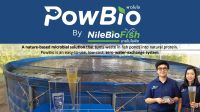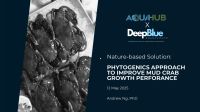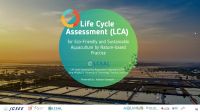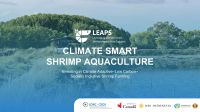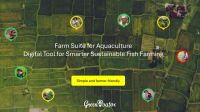PowBio is a microbial inoculant developed by NileBioFish (NINEBIO GROUP Co., Ltd.) in Thailand to support sustainable biofloc aquaculture systems. Co-developed with Maejo University’s Faculty of Fisheries and Aquatic Resources and supported by the Thailand National Innovation Agency, PowBio uses high-efficiency microorganisms to turn fish pond waste into natural protein. By reducing ammonia and nitrite levels, improving water quality, and recycling nutrients within ponds, PowBio helps farmers cut feed costs, lower water exchange needs, and reduce chemical inputs. The result is healthier harvests without muddy off-flavors—delivered through a practical, low-cost, and easy-to-use solution for more productive and resilient aquaculture. This pitch was presented by Nissara Kitcharoen of NileBiofish.
DeepBlue Aquaculture, the world’s largest soft-shell crab operation, is pioneering the use of phytogenics to improve mud crab growth performance. Soft-shell crab farming is traditionally labor-intensive and low-yield, making it difficult to scale. Their proprietary plant-based additive, PhytoEcR, boosts mud crab growth and moulting rate—delivering up to 20% higher weight gain after 45–60 days, with a 40% increase in moulting rate and 35% faster moulting compared to control groups. PhytoEcR is now moving into commercial-scale testing, aligning with global trends in phytogenic feed solutions to enhance productivity and sustainability. This pitch was presented by Andrew Ng of Deep Blue aquaculture.
This presentation introduces a life cycle assessment tool designed to evaluate the sustainability of nature-based aquaculture practices. The tool measures environmental impacts such as carbon footprint and supports farmers, researchers, and policymakers in identifying mitigation strategies for more eco-friendly production systems. This pitch was presented by Kobboon Kaewpila of the Life Cycle Sustainability Assessment Laboratory, King Mongkut’s University of Technology Thonburi.
LEAPS is a climate-smart aquaculture initiative in Java that combines shrimp farming with mangrove restoration to strengthen coastal community resilience. Implemented under the AQUADAPT program with funding from Global Affairs Canada and IDRC, the project promotes inclusive, nature-based approaches for small-scale shrimp aquaculture. By integrating real-time IoT water quality monitoring, wastewater treatment and gender-responsive practices, LEAPS reduces greenhouse gas emissions while restoring mangroves and supporting communities. The project also informs evidence-based policy, helping scale sustainable aquaculture solutions across the region. Aligning shrimp farming with ecosystem restoration, LEAPS supports both livelihoods and climate adaptation. This pitch was presented by Rocky Pairunan and Burhanuddin Zein.
Farm Suite by Greenovator is a digital farm management tool tailored for aquaculture in Myanmar. The platform helps farms and agribusinesses streamline planning and daily operations by tracking activities, inputs, and yields through a real-time, business-grade dashboard. Recognised as a top-3 innovation in the Grow Asia Challenge, Farm Suite provides an affordable, professional alternative to manual record-keeping. With its mobile app interface, it delivers actionable insights that empower aquaculture managers to boost productivity and sustainability. This pitch was presented by Yin Yin Phyu.
